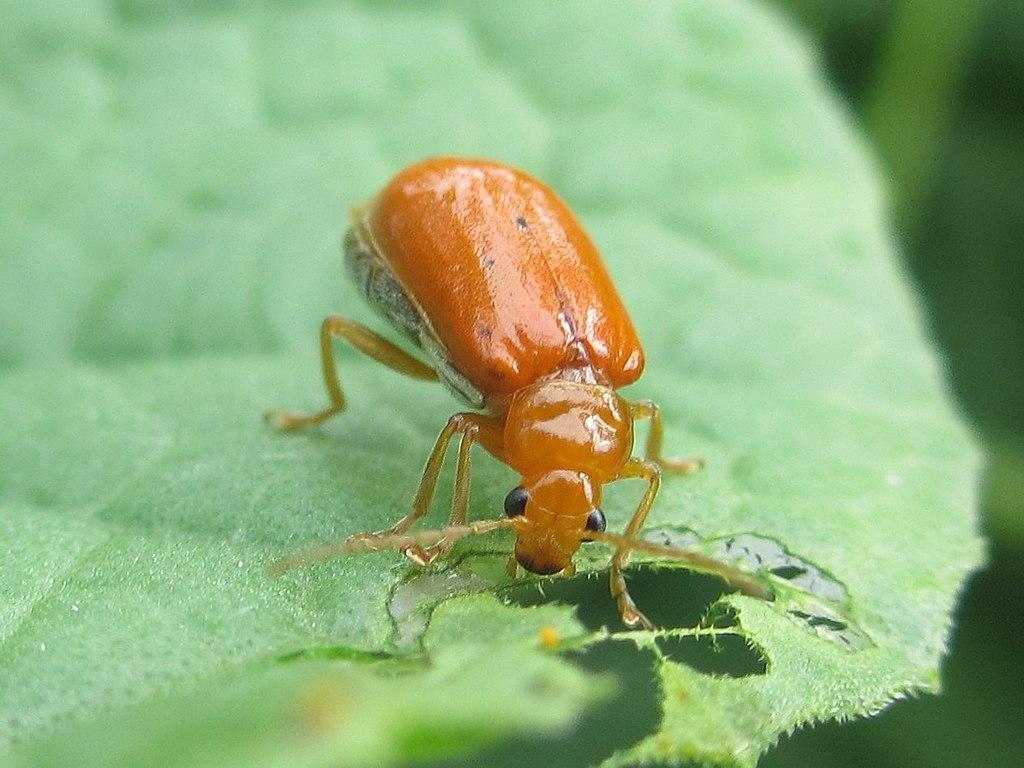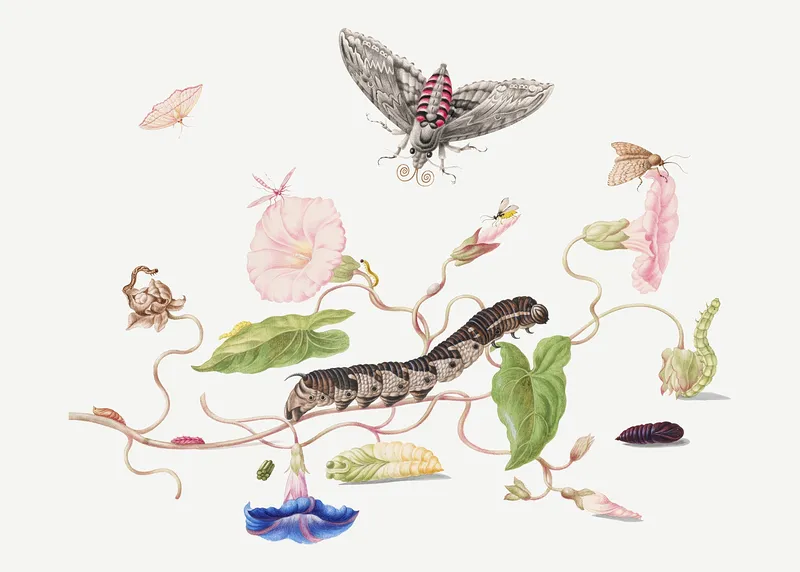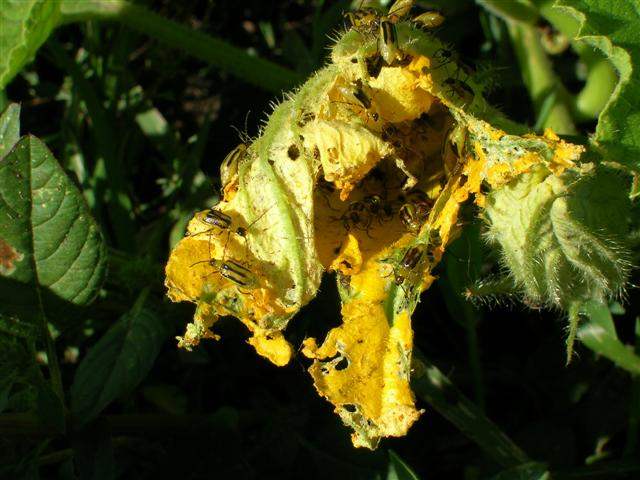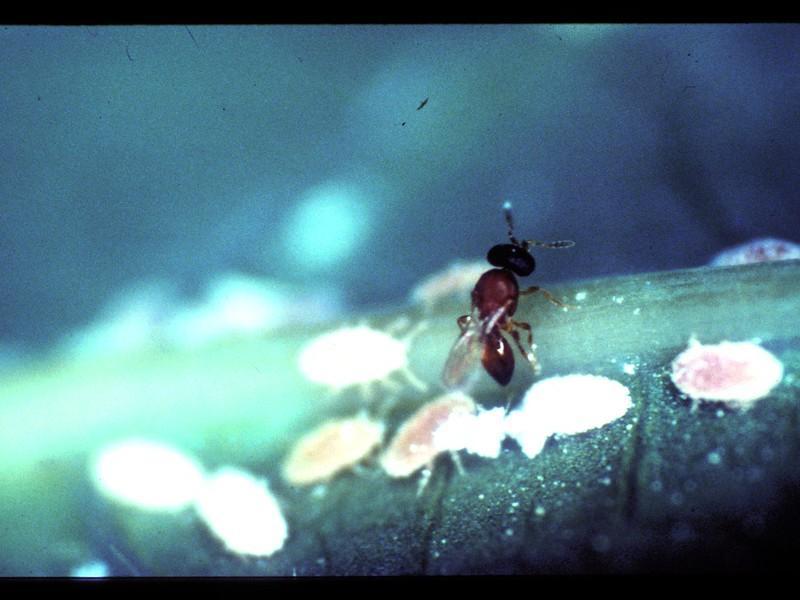While weeding your garden, you come upon a bug that has a brilliant orange color, long antennae, no markings on its body, and beady black eyes. It resembles a slightly enlarged ladybug, but it is not. Instead, the bug you are looking at is the red pumpkin beetle. Read on and find out how to differentiate bright orange bugs with beady black eyes ladybugs.

The red pumpkin beetle likes to eat young leaves, which sometimes makes it hard to grow seedlings.
Adult red pumpkin beetles are nearly rectangular, glossy, and orange-red. They lay yellow eggs that are visible on the ground near the base of the plant.
The red pumpkin beetle eats leaves and bores relatively large holes. Therefore, young plants, including seedlings, are more vulnerable to damage.
Additionally, damage to immature plants can drastically slow down the growth of the crop. During a severe infestation, the red pumpkin beetle also attacks and damages fruits and flowers.
Red Pumpkin Beetle
Identification

The adult red pumpkin beetle is almost rectangular, shiny, and orangey red.
The mature red pumpkin beetle is between 5 and 8 mm (0.2 and 0.3 in) long and around 3.5 mm (0.14 in) wide. Their wings are light orange-yellow, vivid orange-red, or medium brown. In contrast, the abdomen is black with soft white hair.
Larvae of the red pumpkin beetle are usually found in the soil. They are slender, creamy-yellow worms with pale brown heads and prothorax.
While the red pumpkin beetle prefers pumpkin above other varieties of cucumber, it will also consume squash, muskmelon, sponge gourd, cucumber, and watermelon.
The geographic range of the red pumpkin beetle includes southern Europe, Asia, Australia, and Africa. It is a significant pest of cucurbit crops in northwest India.
Related: An Introduction to Flea Beetle plus How to Get Rid of this Garden Pest?
Life Cycle

It takes the red pumpkin beetle around 25-37 days to go through its entire life cycle.
At the start of the spring, near March, red pumpkin beetles emerge from their hiding ground and start eating vigorously on fresh spring growth, such as new shoots and flowers. Spring is also the mating season for the red pumpkin beetles.
Following mating, the female lays batches of roughly eight eggs into the soil. It takes one to two weeks for these orange oval eggs to hatch.
Initially, the larvae, i.e., beetle grubs, feed on soil-contact components of the host plants, such as roots and leaf fragments. As they grow, they go through four molts and pupate in clay chambers that are located just below the soil’s surface.
The adult beetles emerge after another week to two and a half weeks, climb the host plant, and begin feeding on the aerial components of the plants. Following spring, throughout the summer, there might be four or five generations of red pumpkin beetle.
Damage

The Red Pumpkin Beetle is the most serious pest of the cucurbits.
Larvae of the red pumpkin beetle damage plants by eating the leaves and fruits in the lower part, closer to the soil. These larvae grubs also damage roots by digging into the soil. This makes plants vulnerable to fungal and bacterial infections, resulting in faster decay.
In contrast to larval stages, the adult red pumpkin beetles gorge on leaves, puncturing the leaf lamina with irregular holes. As a result, raising seedlings can occasionally be quite challenging since the red pumpkin beetle tends to eat fresh growths.
However, they do not just restrict themselves to new growth. Adult pumpkin beetles will also feed on the leaves of fully developed plants by eating the tissue between the leaf veins and leaving behind a skeleton-like structure.
If the infected plants die, the crop might need to be replanted. Furthermore, as the red pumpkin beetle feeds on the plant, the smaller, younger fruits begin to decay, while the larger, more mature fruits lose their suitability for human consumption.
Related: Are Japanese Beetle Traps Helpful for Organic Pest Management?
Management
Since the red pumpkin beetle is capable of causing significant harm to plants, its population must be kept under control. There are a variety of approaches that can be taken to control the red pumpkin beetle, some of which are described below.
Biological Control

Biological control is the management of pests by the use of living creatures.
Nature has unique systems for controlling and maintaining a healthy balance between different species. Parasitism is just one example of how nature regulates the population of a species through natural processes.
It can also be used to control the red pumpkin population in a garden.
Members of the Tachinid family and Reduviid rhynocoris fuscipes are excellent natural predators of the red pumpkin beetle. Therefore, introducing these species in your garden can effectively lower the red pumpkin beetle population.
Organic Control

Organic pest control solutions employ fewer pesticides and chemicals.
Organic control refers to ways of eradicating insects by using pesticides that are organic. Organic pesticides should always be preferred over chemical insecticides as they do not harm the environment and plants.
An effective organic pesticide can be created by filtering together one and a half cups of wood ash, one and a half cups of lime, and four liters of water. This concoction can then be used to kill the red pumpkin beetles in your garden by spraying it onto the leaves.
Neem oil is another potent organic pesticide that can be used to treat pest populations on plants. Just add a few drops of neem oil along with some dish soap into a cup of water and spray it onto your plants to get rid of all kinds of bugs.
Related: Black Beetles 101: Types and A Comprehensive Identification Guide with Pictures
Chemical Control

Chemical control involves using chemicals to kill pests or inhibit their essential behaviors.
Chemical control includes managing pests with synthetic pesticides, which often harm the plant and environment. They should only be used as a last option, but sometimes, chemical control is the only option if you want to save your plants.
Deltamethrin is an insecticide often used to get rid of red pumpkin beetles. Product guidelines should be strictly followed as chemical pesticides may damage the plants if used otherwise. Apart from deltamethrin, synthetic pyrethroids can also be used to control the red pumpkin beetle infestation, but they can also harm other insects.
Likewise, fenitrothion is another insecticide that can be sprayed as soon as red pumpkin beetles are detected. Repeat the spray after 15 days for the best results.
Cultural Control

Cultural control methods include better garden care practices to get rid of bugs.
Red pumpkin beetle eggs require moisture to hatch. Creating furrows around the plants that the beetles enjoy eating can help keep the eggs dry and prevent them from hatching.
For instance, when rather than watering the plants directly, water is poured into the furrows, it will keep the eggs near the base of the plants dry.
Another helpful method of protecting your plants is to use polythene bags. Polythene bags are placed over seedlings to shield them from red pumpkin beetles.
A study conducted by CABI in 2014 compiled data suggesting that “covering seeding beds with mosquito netting could shield them from the worst beetle predation.”
Remove any eggs or insects that may be hiding on the plants you already have in the yard, and then weed the garden beds before planting any new seedlings or plants into the ground.
Burning these weeds or removing them in some other way from the vicinity of your garden will also keep your plants safe.
Furthermore, space out the veggies that red pumpkin beetles prefer. For instance, avoid planting pumpkins and cucumbers together. This also helps control the beetle population.
Final Thoughts
Even though it is said to be fortunate to see a ladybug, the bright orange beetle with the dark eyes is not a ladybug, and seeing it is definitely a bad omen for your garden. The red pumpkin beetle is a pest that causes significant damage to a wide variety of food crops.
The most effective method of eradication is to use a mix of natural or synthetic pesticides, in addition to practicing sound gardening management.
Frequently Asked Questions
How do you get rid of red pumpkin beetles?
According to several studies, Carbaryl (46.53%) is the most effective control strategy in reducing the number and infestation of red pumpkin beetles. However, resorting to chemical procedures should be an absolute last resort. Eradicating the beetles with good garden care and organic compounds should always be your first choice.
What is the scientific name of the red pumpkin beetle?
The scientific name of the red pumpkin beetle is Aulacophora foveicollis. It is a species of beetle in the Chrysomelidae family. It is a foliar pest of Cucurbitaceae plants, especially the pumpkin. The geographic range of A. foveicollis includes southern Europe, Asia, Australia, and Africa.
What do red pumpkin beetles eat?
The Pumpkin Beetle feeds on the leaves and blooms of pumpkins, cucumbers, and melons, among other plants. Additionally, the red pumpkin beetle favors feeding on young leaves; as a result, it can be quite challenging to grow seedlings in some cases.
What is the damaging stage of the red pumpkin beetle?
The red pumpkin beetle feeds on the plants at practically every stage of their development. Damage done to young seedlings is frequently catastrophic because it causes a delay in the maturation of the crop. However, if the flowers are damaged, it will reduce the number of fruits.
Sources For Further Reading
Fact sheet – Pumpkin beetle (040). (2022). Retrieved 12 August 2022, from https://apps.lucidcentral.org/ppp/text/web_full/entities/pumpkin_beetle_040.htm
Editor’s Recommendations
What are the Best Practices to Get Rid of Thrips on Houseplants?







